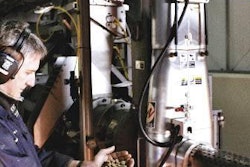The Association of American Feed Control Officials (AAFCO) held its mid-year meeting in Savannah, Georgia, USA, on January 16-18, 2007. The mid-year meeting is when most of the committees finalize their proposals to go before the board and full membership for action at the annual meeting in August. If eventually passed, a number of proposals will affect the petfood industry.
Pet Food Committee
Certainly the most controversial issue before the Committee, and the one that took up the bulk of the session, was the American College of Veterinary Nutrition's proposal to amend the Model Pet Food Regulations that would, among other things, make calorie content statements mandatory on all dog and cat food labels. After extensive discussion, the matter was sent to a newly formed working group of committee members and advisors (including myself). The group is charged with reviewing the pros and cons of the proposal and reporting its findings back to the Committee.
Among other topics, the expert members of the panel charged with revision of the AAFCO Dog and Cat Food Nutrient Profiles and feeding trials were named (see Industry News, p. 10). The National Research Council's recently published Nutrient Requirements of Dogs and Cats will be among the new information to be considered in the Profile revisions.
The Committee also accepted "snouts" to be included in the list of pet chew items (e.g., rawhide, ears, bones) potentially exempt from state registration and labeling requirements under Policy Statement No. 27, although "pizzles" was rejected from inclusion at this time. Finally, plans for a regulatory workshop on petfood labeling were announced, tentatively scheduled to take place at next January's meeting.
Ingredient Definitions Committee
While not as contentious as the discussion on calorie statements in the Pet Food Committee session, a topic that really raised some eyebrows among the petfood industry audience at the Ingredient Definitions Committee session was the proposal to "clarify" the definition for meat meal. As proposed, it would eliminate all bone, organs and other mammalian tissues except for "meat" from inclusion in the meal. The trouble as I see it is that the ingredient as redefined doesn't exist, nor has it ever existed, on the market. Since this item was only recently proposed, no action was taken, and time is being given for interested parties to comment.
Other pertinent items include a change in the conversion factor used to estimate the amount of choline in choline chloride from 0.868 to 0.746. This is important information for formulators to consider when determining whether a product meets the AAFCO Dog or Cat Food Nutrient Profiles. With the change in the conversion factor, more choline chloride will need to be used to assure adequate levels of choline in the product.
Model Bill and Regulations Committee
After many years of discussion and revision, the Committee finally accepted the Pet Food Committee's proposed Policy Statement No. 29. While there are several other steps before this policy can come into effect, when and if it does this would allow for "informational statements" regarding the physiological roles of nutrients in ingredients on petfood labels that would not trigger the need for supporting guarantees under the Model Bill. There will still be significant restrictions for the policy to apply, though. For example, the informational statements cannot appear on the principal display panel, nor can they make any quantitative or comparative claims.
With respect to other issues, the Committee had made progress in making the Model Bill gender neutral (i.e., eliminating words such as "he" and "his" from the document), but further revisions are needed to correct some grammatical issues. The Committee is also making final changes to the Non-Commercial Feed Bill, revising the definition of "feed ingredient" to make it consistent with other uses of the term in the AAFCO Official Publication, and may be looking at revising net quantity statement regulations to specify both avoirdupois and metric units.
Other committees
There was an effort to make final revisions to the proposed feed safety regulations during the Feed Manufacturing Committee session, but the process was quickly bogged down. It was difficult even to reach consensus on the name of the document (I believe it's now "AAFCO Model Regulations for Safe Feed and Feed Ingredient Manufacturing"). The Committee intends to work on changes further before the next meeting. Assuming the remaining issues can be resolved, the new regulations will have significant impact on the petfood industry, since they will mandate what essentially are good manufacturing practices on all manufacturers.
The Feed Labeling Committee is concerned about the misuse of trademarks, logos, seals and similar endorsements on labels. A proposal to provide feed control officials with guidance in assessing the truthfulness and appropriateness of third party claims is now open for comment. Due to the resignation of its chair, the Carbohydrate Working Group under the Feed Labeling Committee did not get an opportunity to meet, but a new chair has been appointed.
The open session of the Enforcement Committee lasted only a few minutes, possibly setting a new record for shortest meeting in AAFCO history. There was the hint of a possible "enforcement event" in upcoming months. No details were offered, but if similar to previous events, a group of states would conduct a coordinated effort against a targeted class or category of non-compliant products over a short period of time.
Finally, a symposium on use of biofuel co-products in animal feed was held. Both regulators and industry members gave presentations on the subject. Details on the symposium will be discussed in an upcoming column.


















